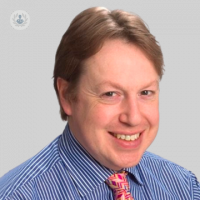Ear moulding in newborns: A non-surgical solution
Written by:In his latest online article, Mr Guy Thorburn gives us his insights into neonatal ear moulding. He talks about what it is, how it corrects ear deformities in newborn babies, the common types of ear deformities that can be treated, the optimal time to initiate neonatal ear moulding, how long treatment lasts, potential risks and complications and success stories.

What is neonatal ear moulding, and how does it correct ear deformities in newborn babies?
Ear deformities are fairly common in newborn babies. Ear moulding uses a medical device during infancy to gently hold the ear cartilage in a better shape. Newborn babies have high levels of circulating oestrogens that make cartilage malleable. By holding the ear cartilage in a better position while it hardens, the ear keeps that new shape. By using these devices, the aim is to avoid the need for operations later in life. Mr Thorburn is experienced with using the Ear Well system.
Which common types of ear deformities can be treated through neonatal ear moulding?
Prominent ear deformity is the most common, and ear moulding works very well for this. It also works well for other patterns such as lidding, cup ear, stahl’s bars, helical rim anomalies, conchal crus, cryptotia and constricted ears. It usually will not work for microtia or anotia.
When is the optimal time to initiate neonatal ear moulding after birth for the best results?
Timing is essential for this nonsurgical treatment because it takes advantage of the soft and malleable ear cartilage that is present from birth up until about 6 weeks of life. This malleability is a result of high levels of circulating maternal oestrogen, which reaches its peak during delivery. The maternal oestrogen increases levels of hyaluronic acid, causing the cartilage to become more pliable and amenable to moulding from external forces. Circulating maternal oestrogen begins to decline in the infant at 3 days of age up until around 6 weeks of age.
How long does neonatal ear moulding treatment typically last, and how frequently are follow-up visits required?
Ear moulding treatment usually lasts 4-6 weeks. The length of treatment depends on the complexity of the initial deformity, and the age at starting the treatment. When the treatment can be started soon after birth, it tends to work more quickly. Each Ear Well device needs replacing after about 2 weeks.
What are the potential risks or complications associated with neonatal ear moulding, and how are they managed?
The treatment is not surgical, so this avoids the potential risks and complications related to surgery and anaesthetics.
It is typically necessary to trim some hair around the ear to make removal of the Ear Well device more comfortable. The treatment is not painful, and often babies will sleep through the whole process (if possible, try to time a feed for just before the treatment).
If the ear is getting sore, the device may need adjusting, so parents should contact Mr Thorburn to have it checked.
Sometimes the Ear Well adhesive, or the top of the shell, can lift off – wearing a beanie-type hat or an Ear Band-it type ear protector over the top can help with this.
In some babies, their skin can get irritated by the adhesive or by having the skin covered – this generally settles quickly.
Could you share some success stories or patient testimonials related to neonatal ear moulding treatment?
There are photos and videos of the treatment and patient results here.
Mr Guy Thorburn is a distinguished adult and paediatric plastic surgeon with over 25 years of experience. You can book an appointment with Mr Thorburn on his Top Doctors profile.


